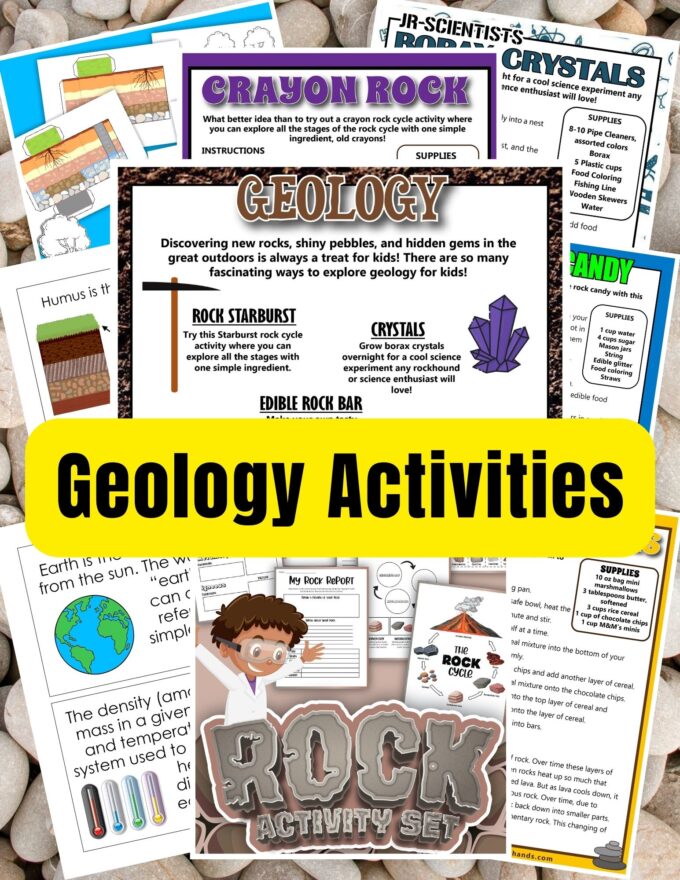Have you ever wondered how the rocks you find on the ground were made? Well, they are called sedimentary rocks and form in fascinating ways! Today, we will discover the exciting process of how sedimentary rocks are formed, explore different types, and learn about the amazing things they can tell us about Earth’s history.
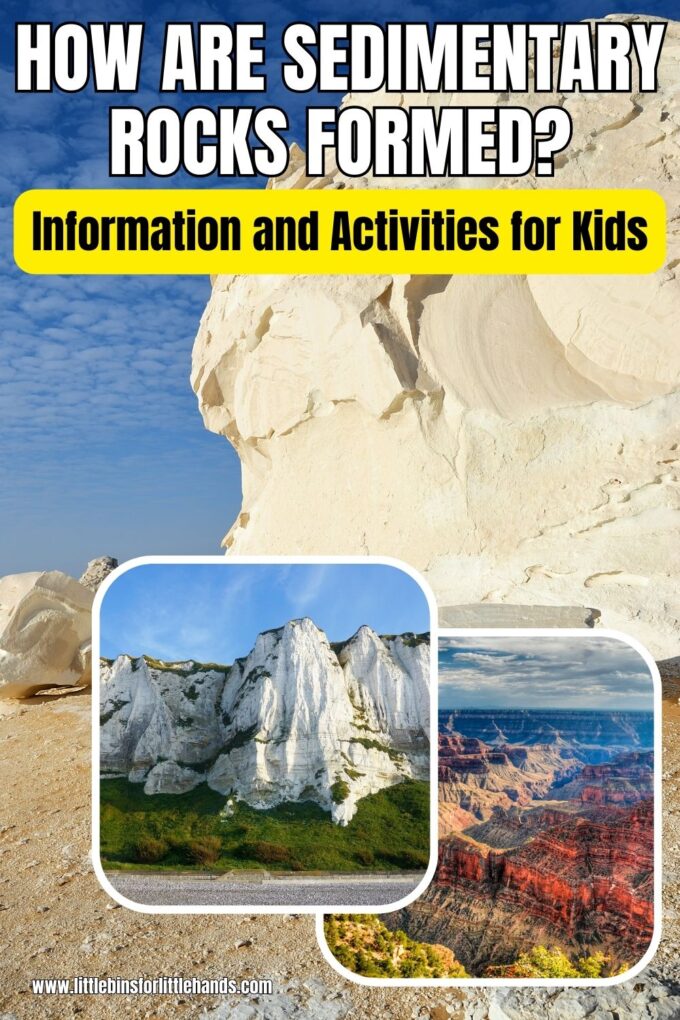
What Are Sedimentary Rocks?
Sedimentary rocks are one of the three main types of rocks, alongside igneous and metamorphic rocks. These rocks are made from tiny particles of rocks, minerals, and even organic material like plants and shells. Over millions of years, these particles, known as sediment, are pressed together and become solid rock. You can find sedimentary rocks on the Earth’s crust, covering large parts of its surface.
Types of Sedimentary Rocks:
Clastic Sedimentary Rocks
Clastic rocks are a special type of sedimentary rocks made from broken pieces of other rocks, known as rock fragments. These rock fragments, called sediment, come from big rocks that have been broken down by physical processes like wind, water, or ice. When these large boulders are eroded by natural forces, they break into smaller particles, eventually forming clastic rocks.
Examples of clastic sedimentary rocks include sandstone, which is made up of tiny grains of sand cemented together, shale, which is made up of very fine particles like clay minerals, and conglomerate, which is made up of larger pebbles and fragments of other rocks stuck together.
Organic Sedimentary Rocks
Organic sedimentary rocks form from the remains of plants and animals that lived long ago. When plants and animals die, their bodies and shells settle on the ocean floor or in other bodies of water. Over time, the organic matter gets compressed and forms solid rock, like limestone forms from the accumulation of shell fragments and coral.
Chemical Sedimentary Rocks
Chemical rocks form when minerals dissolve in water and then later crystallize or harden to create rocks. This happens through a process called chemical weathering, where water interacts with minerals in rocks, dissolving them and carrying them away. When water evaporates, it leaves behind the minerals, which then precipitate and form chemical rocks, such as rock salt and gypsum.
Formation of Sedimentary Rocks
Sedimentary rocks form in different ways, but the best way to understand their formation is by looking at the three main steps: weathering, transportation, and deposition. During weathering, rocks are broken down into smaller particles, like sand and gravel. These sediments are then transported by water, wind, or ice to new locations. Finally, they are deposited, where they accumulate and undergo compaction and cementation to form solid sedimentary rock layers.
Grand Canyon, USA: The Grand Canyon in Arizona is one of the most iconic and impressive examples of sedimentary rock formations. It was carved by the Colorado River over millions of years, exposing layers of sedimentary rocks that tell a geological story.
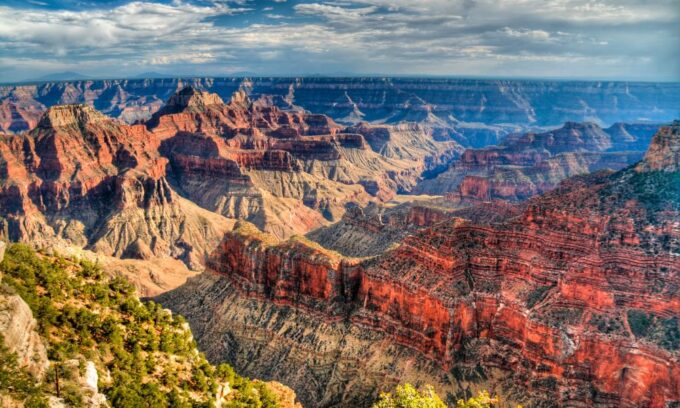
Types of Rock Layers
When sedimentary rocks are formed, they often develop distinct layers. These layers can be horizontal, showing how the sediments were deposited over time. In some cases, low-temperature form of rock metamorphism may occur, causing changes in the rock’s mineral composition due to pressure and heat. Chemical precipitation is another process that contributes to the formation of sedimentary rock layers, like when calcium carbonate precipitates and forms limestone.
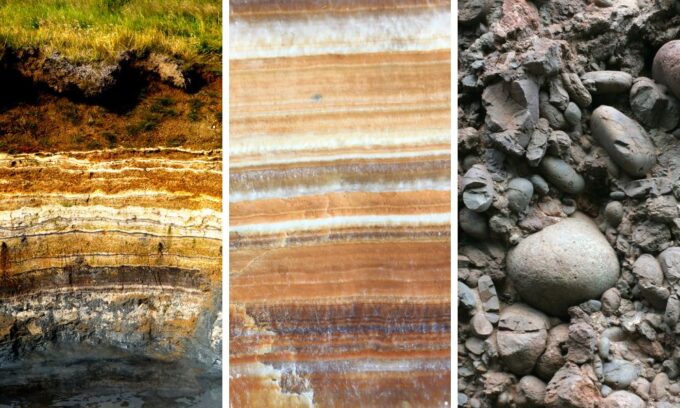
Examples of Sedimentary Rocks
One classic example of a sedimentary rock is sandstone, which is made of smaller particles of sand and often has sharp edges due to its formation process. Another common sedimentary rock is shale, which is made up of tiny particles, and when it contains iron oxide, it appears red in color. Limestone, formed from the accumulation of shell fragments and coral, is another important type of sedimentary rock.
Sedimentary rocks are incredibly important because they can reveal clues about Earth’s history, containing fossils, ripple marks, and other evidence of past environments. From plant roots found in sedimentary rock layers to alluvial fans formed by rapidly flowing mountain streams, these rocks hold valuable information about the planet’s past.
In marine environments, sedimentary rocks can form when loose sediments settle on the ocean floor. Over time, these unconsolidated sediments become compacted and cemented to form rocks, often containing large fragments and pieces of rock.
Biologic sedimentary rocks, like coal, are created from buried plant remains, and they are an excellent example of organic sedimentary rocks. On the other hand, chemical sedimentary rocks like rock salt form when water molecules evaporate, leaving behind salt compounds.
White Cliffs of Dover, UK: The White Cliffs of Dover are famous chalk cliffs on the southern coast of England. Chalk is a soft, fine-grained, white limestone formed from the accumulation of microscopic marine organisms over millions of years.
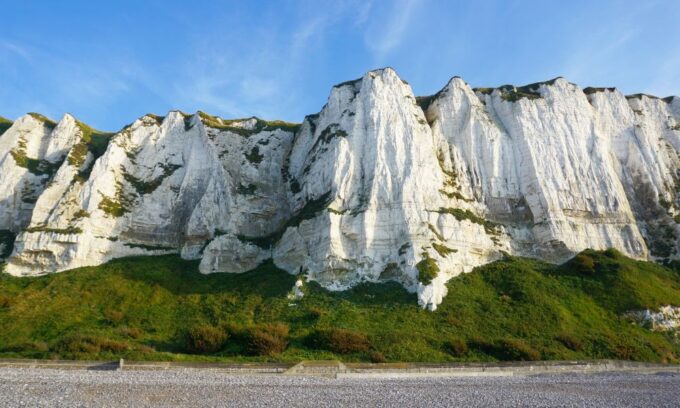
What are depositional environments?
Depositional environments are the places where sedimentary rocks form. Some examples of these environments include rivers and lakes, oceans and seas, as well as deserts and sand dunes. In each of these locations, the process of weathering, erosion, transport, and deposition of sediment occurs, leading to the formation of sedimentary rocks over time.
The unique characteristics of each depositional environment contribute to the different types of sedimentary rocks found throughout the Earth’s surface.
The White Desert, Egypt: The White Desert, also known as the Sahara el Beyda, is a unique and otherworldly landscape of chalk rock formations in Egypt’s Farafra Depression. These chalk and limestone formations were once submerged under ancient oceans.
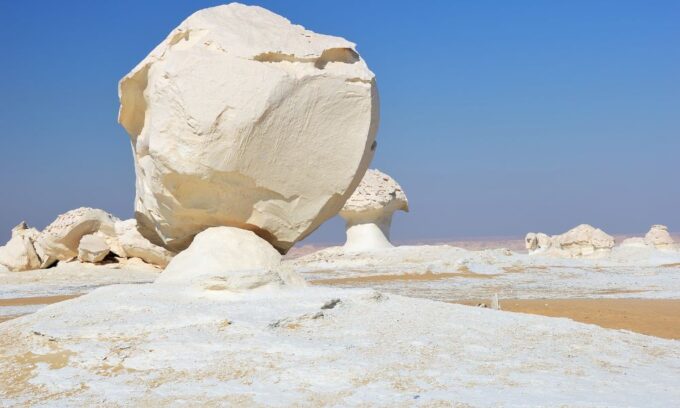
Sedimentary rocks hold many secrets about Earth’s history
Sedimentary rocks are like the storytellers of Earth’s history, holding clues and evidence of the past within their layers. Through chemical processes, natural reactions, and physical forces, they come into existence, shaping our planet’s landscape and revealing fascinating insights about its ancient environments.
From limestone formations to sandstone with sharp edges, each type of sedimentary rock has a unique tale to tell. So, the next time you see a sedimentary rock, remember that it carries millions of years of history within its grains, waiting for you to explore its secrets. Happy rock exploring!
Sedimentary Rocks and the Rock Cycle
The rock cycle is a continuous process that shows how rocks can change over time. It involves three main types of rocks: igneous, sedimentary, and metamorphic rocks. Let’s look at how sedimentary rocks fit into the rock cycle!
Weathering and Erosion: The rock cycle starts when big rocks on the Earth’s surface are broken down into smaller pieces by wind, water, and ice. This is called weathering and erosion. Imagine a giant rock getting smashed into small pebbles.
Transportation: The little pieces of rocks and minerals get carried away by rivers, streams, and other natural forces. They might travel far from their original home, like taking a big adventure!
Deposition: The small rock pieces eventually settle in new places, like the bottom of a lake or the ocean. They pile up on each other and create layers, just like when you build a tower with building blocks.
Compaction and Cementation: As more and more rock pieces stack up, they start to get squeezed by the weight of the layers above them. It’s like squishing the layers together. Some natural substances act like glue and hold the rock pieces together. This is called cementation.
Formation of Sedimentary Rock: Over millions of years, all that squeezing and sticking together turns the layers of rock pieces into solid sedimentary rocks. It’s like making a pancake by pressing together all the layers of batter.
The Rock Cycle Continues: Remember that the rock cycle is a never-ending process. So, these sedimentary rocks can change into other types of rocks too! If buried deep in the Earth’s crust, they might get heated and squeezed to become metamorphic rocks. Or, if they get melted deep within the Earth and then cool down, they can turn into igneous rocks!
Get Your Free Printable How Do Rocks Form Pack
Sedimentary Rock Activities for Kids
Below you’ll find various hands-on activities for kids to learn more about and explore sedimentary rocks. Look through our complete geology activities collection if you have a rock hound on your hands!
Sedimentary Layers Model: Use colored Play-Doh or clay to create layers representing various sedimentary rock types. Demonstrate how layers build up over time to form sedimentary rocks.
Sediment Sorting: Provide kids with mixed sediments like sand, pebbles, and silt. Have them sort the sediments by size using sieves, just like nature sorts sediments in different layers.
Fossil Hunt: What is a fossil? Learn all about what a fossil is, and see how to set up two fun fossil activities for kids.
Sedimentary Rock Identification: Show kids pictures or samples of common sedimentary rocks and let them try to identify each rock type based on its appearance and texture. Check out our free Be A Collector Pack and start a rock collection.
Rock Cycle Book Idea: Read a picture book or story about sedimentary rocks and the processes involved in their formation. “The Rock Factory” by Jacqui Bailey is a great example.
Rock Layer Snack Bars: Make rock cycle snack bars with multiple layers representing sedimentary rock layers.
Erosion Demonstration: Using a cracker and a toothpick, learn more about the effects of erosion on the environment.
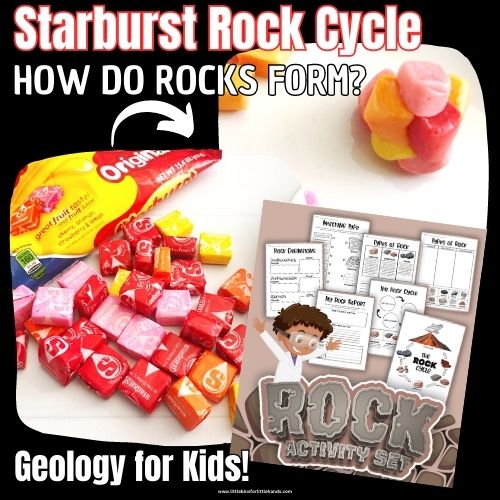
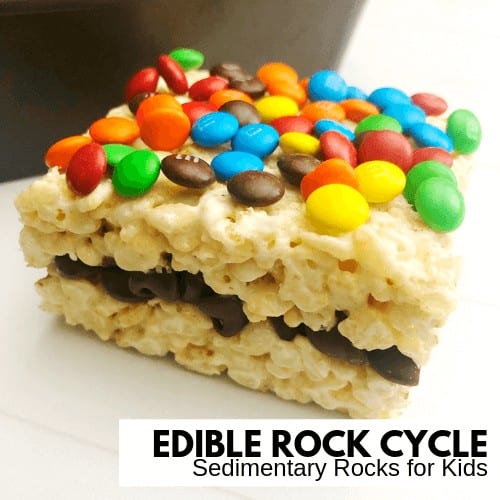
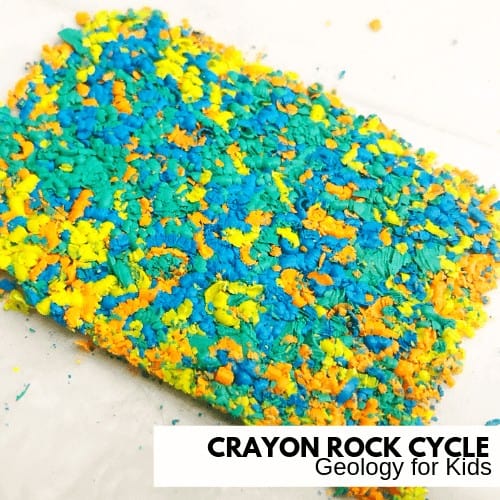
Printable Geology Pack for Kids
Kids love rocks, and this easy-to-use geology pack is a fantastic way to encourage their passion for exploring, learning, and collecting!
WHAT’S INCLUDED:
- 8+ Hands-On Learning Activities exploring crystals, rocks, and volcanos
- Additional mini-packs include materials to learn about soil layers, layers of the earth, and the rock cycle!
- Extras include: vocabulary words, fun games, projects
- Be a Collector Pack: start a rock collection like a geologist
